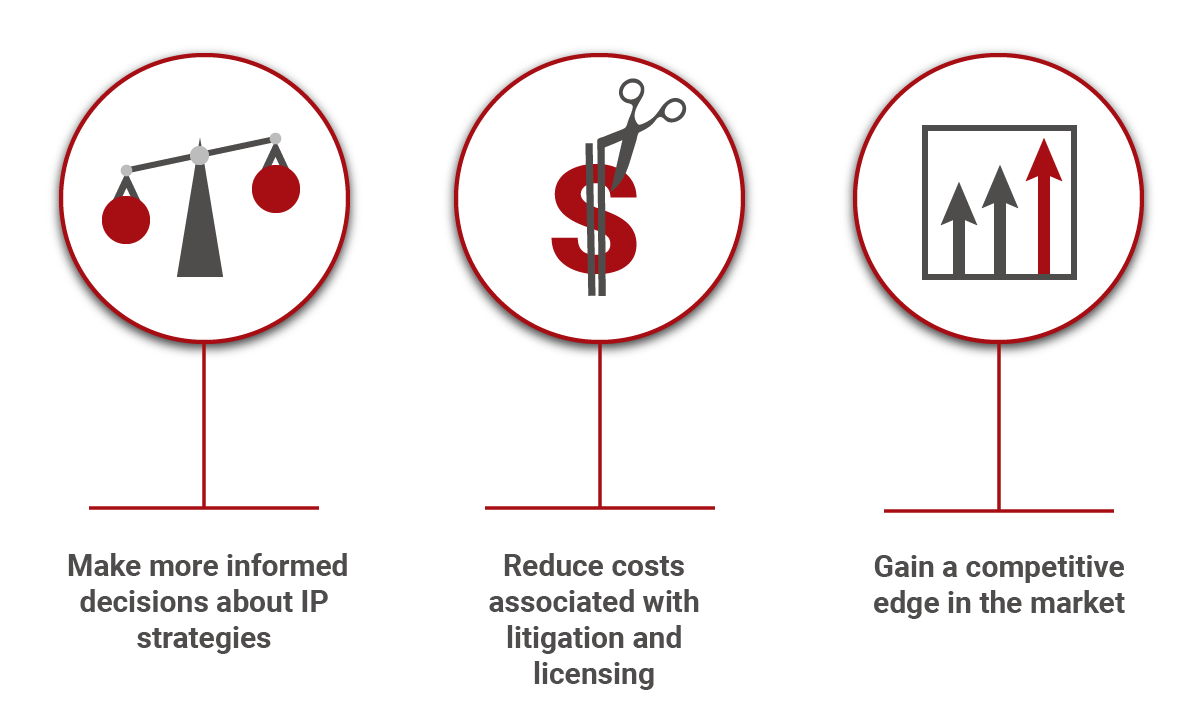Table of Contents
- What is Intellectual Property?
- What is an Intellectual Property Database?
- The Need for Intellectual Property Software
- IP Software for Solving Business Problems and Relieving Pain Points
- Features of Intellectual Property Software
- Choosing the Right Intellectual Property Software
- Solve Research Problems and Drive Growth with ktMINE’s Intellectual Property Software
- Intellectual Property Software FAQs
- Conclusion
Intellectual property (IP) is a critical component of business and innovation. To monitor the intellectual property landscape effectively, businesses require IP software that provides comprehensive data coverage, powerful search functionality, automated alerts, analytics, and reporting.
In this article, we will explore the features and benefits of intellectual property software, including what to consider when selecting the correct IP database for your unique needs.
What is Intellectual Property?
Intellectual property refers to a set of legal rights that protect inventions, artistic works, symbols, names, images, and designs used in commerce. These assets hold value for their owners and represent significant time, effort, and resource investments. IP laws provide a framework for protecting these intangible assets and granting their owners exclusive rights to use, distribute, and profit from them.
The value of intellectual property lies in its ability to generate economic benefits for its creators and owners. As an example, patents allow inventors and companies to protect their innovations and prevent others from producing, selling, or using their inventions without permission. This exclusivity provides inventors and companies with a competitive advantage. They can bring products to market and generate revenue.
IP laws are designed to encourage innovation and creativity by providing legal protection and incentives to inventors, creators, and entrepreneurs. By providing a framework for protecting and commercializing intellectual property, these laws help to foster innovation and drive economic growth. For additional details, you can refer to the USPTO for the US patent process, patent basics, and US trademark process. Details on PCT and international filings can be found on the WIPO site.
What is an Intellectual Property Database?
An intellectual property database collects information related to IP. Typical examples of intellectual property information contained in databases include patents, trademarks, and in some cases copyrights or even trade secrets. These databases offer insights into the assets including the owner, desired and expected use, location, and related details that enable users to find information to assess the IP.
The Need for Intellectual Property Software
These IP databases and associated software enable users to perform necessary IP research. Here are some examples of why they are needed.
Helps with prior art searches: Prior art searches are essential to identify existing intellectual property that may impact a new patent application. Intellectual property databases can help practitioners search through a vast amount of data to identify relevant prior art.
Supports trademark clearance searches: Trademark clearance searches are essential to identify potential conflicts before filing a new trademark application. Intellectual property software can help practitioners search for similar trademarks that may conflict with their client’s proposed mark.
Helps with monitoring competitors: Intellectual property databases can be used to monitor the intellectual property assets of competitors. This provides valuable insights into a competitor’s technology and business strategy.
Supports due diligence: Intellectual property databases can be used to support due diligence activities, such as assessing the intellectual property assets of a company during a merger or acquisition.
Assists in identifying the value of assets: Intellectual property software can be used to value IP by benchmarking known royalty rates for assets against the assets in question.
IP Software for Solving Business Problems and Relieving Pain Points
IP software has revolutionized the way businesses conduct IP research by streamlining the process and providing advanced tools for analysis. Businesses often face pain points related to the time-consuming and complicated process of conducting a comprehensive research. IP software provides a powerful solution by simplifying the search process and enabling businesses to quickly identify relevant patents, trademarks, and other IP-related assets. These solutions also provide businesses with advanced analytical tools to evaluate the strength and potential value of their own IP portfolios and identify potential areas of improvement. By relieving the pain points associated with IP research, IP software helps businesses make more informed decisions about their IP strategies, reduce costs associated with litigation and licensing, and ultimately, gain a competitive edge in their respective markets.
Features of Intellectual Property Software
Intellectual property software commonly contains features that make the use of the products beneficial.
Data coverage: Global coverage of IP information to ensure users can find assets within any jurisdiction of interest.
Search functionality: IP software databases provide users with powerful search functionality to help them find specific intellectual property information based on various criteria, such as keyword, owner, filing date, and more.
Automated alerts: IP databases can be programmed to send automated alerts to users so they are instantly updated to any changes.
Analytics and reporting: IP software can provide analytics and reporting functionality that allows users to view and analyze data related to intellectual property assets, such as filing trends, IP owners, and more.

Choosing the Right Intellectual Property Software
Choosing the right intellectual property software and database can be a critical decision for businesses and practitioners who want to evaluate IP assets more effectively. Here are some factors to consider when selecting an IP software database:
Features: The first consideration when choosing an IP software is the features it offers. Look for a database that provides the features you need to manage your IP assets, such as search functionality, document management, analytics and reporting, compliance management, and workflow customization.
Ease of use: An IP database that is easy to use and navigate can save time and increase productivity. Consider the user interface and user experience when evaluating an IP database.
Data accuracy: It is critical that the IP database has accurate and up-to-date data. Check the sources of the database’s data and the processes in place for verifying and updating it.
Cost: IP databases and IP software can vary significantly in price. Consider your budget and look for an IP database that provides the features you need at a price point that works for you.
Support and training: Look for an IP software that offers support and training to help you get the most out of the system. Consider the availability and quality of customer support, as well as the availability of training resources such as user manuals, webinars, and training sessions.
Reputation: Finally, consider the reputation of the IP provider. Look for a provider with a good reputation for quality and customer service. You can read reviews and ask for references from other practitioners to help assess a provider’s reputation.
Solve Research Problems and Drive Growth with ktMINE’s Intellectual Property Software
ktMINE is a leading provider of IP data that offers the largest collection of IP data in a single application. This allows users to conduct comprehensive searches across patents, trademarks, agreements, assignments, and patent court cases, providing a more complete understanding of IP trends than any other provider on the market.
Trusted by top government agencies, law firms, universities, the Big 4 consulting firms, and corporations, ktMINE makes IP data more accessible. Its suite of applications enables users to easily locate patents with direct links to agreements and royalty rates, simplifying the process of calculating and negotiating patent values. With flexible access options ranging from day passes to multi-year contracts, ktMINE ensures that organizations can tailor their access to best meet their unique IP research needs.

Intellectual Property Software FAQs
How do I use an Intellectual Property Database?
Define your research objectives > Choose the right IP database > Conduct your research > Analyze the results > Leverage the information
How do I analyze a patent within an Intellectual Property Database?
Click on the patent to review its details, including the abstract, claims, and drawings. Reviewing these details will help you understand the scope of the invention and its potential value.
How do I analyze a trademark within an Intellectual Property Software?
Click on the trademark to review its details, including the registration date, status, and owner’s name. Reviewing these details can help you understand the trademark’s scope and potential value.
What is the difference between a fee-based and free Intellectual Property Database?
The main difference between a fee-based and a free Intellectual Property database is that fee-based databases offer more comprehensive and advanced features than free databases. Fee-based databases are considered to be more reliable, comprehensive, and efficient than free databases.
What type of data is included in an Intellectual Property Software?
- An IP software database contains a wide range of data related to patents, trademarks, and other forms of IP. Here are some examples of the type of data you can find in an IP database:
- Patent documents, including the title, abstract, claims, drawings, and specifications.
- Trademark registrations and applications, including the trademark owner’s name, registration number, and application date.
Litigation data including information on legal disputes related to intellectual property, such as court documents, decisions, and settlements. - Information on licensing agreements for IP, including the parties involved, the terms of the agreement, and the scope of the license.
Information on companies that own intellectual property, including their names, locations, and financial data.
Conclusion
Intellectual property software offers powerful tools to help users perform prior art searches, trademark clearance searches, monitor competitors, support due diligence activities, and value IP assets.
When choosing an intellectual property software provider, it is important to consider factors such as features, ease of use, data accuracy, cost, support and training as well as reputation. ktMINE offers a comprehensive solution for intellectual property data research, trusted by leading government agencies, law firms, universities, consulting firms, and corporations around the globe. With the largest repository of IP data in a single application, ktMINE helps users understand IP trends and negotiate the value of patents with ease and confidence. To learn more about ktMINE’s IP software offering, contact our dedicated team of IP experts today.



